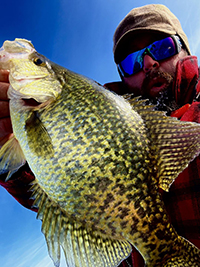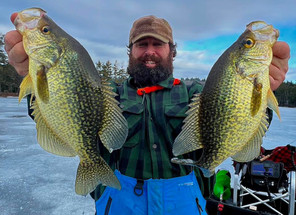Posted by Chris Larsen on 2nd Jan 2023
Ice Camping - What You Should Do Before Going And What Gear You Need For Ice Camping
If you spend some time around the ice fishing shelters at any ice fishing show, you’re going to hear the words “ice camping” used frequently. Heading out on the ice and staying out on the ice is a popular idea these days. But ice camping isn’t a simple endeavor. There are hazards to prepare for and overcome. Joe Holland lives in Maine and has experienced over 100 ice camping trips and documented many of them on YouTube.

Joe’s YouTube channel is called Joe Holland Fishing. He has over 25,000 subscribers and his channel is focused on wilderness and ice camping. But like many other YouTuber’s his channel went through growing pains. “I did a series. I think it was a two-part series. I went for five days. It was the best content I could do at the time. I’m doing my own shooting and my own editing. I’m flying a drone, I’m doing underwater footage, I’m doing over-water footage, I have a hat-cam, a chest cam, and I have tripods all different ways. I have really nice wild brook trout catches. I have drama, the slush came up one night overnight… It took me a week to edit… It was the best thing I could possibly do… I throw it on YouTube and I get nothing. It did nothing at all and I was like, I guess I’m not going to have a YouTube channel. But the trouble is I put it up at the end of March. Ice fishing gets killed. There’s no way you can get traction even if it’s an incredible video… Come next October, the Canadians picked it up. They were getting jacked up for their season. The two videos went from 1,000 views to 100,000 views… So I said, that’s my niche. I love telling stories.”
If you’re thinking about going ice camping, head over to his channel and you’ll likely get a lot of tips for a successful trip. But before heading out on the ice, Joe has some advice. “The best advice I can give anybody thinking about it, number one is, do it. But the first thing to do is set up in your garage, backyard, front yard, or driveway. Set up and do one night pretending you’re on the lake. Do one night at home first, preferably outdoors. Set up and cook there. Do everything but fish for the night so you can see your comfort level. It’s way better than traveling an hour to the lake, getting set up, then learning what you don’t have, and then learning your comfort level. You might not be warm enough. If you do it at home, you have a safety net. You’re going to be like, that was warm enough for me or I need some more heat source. I should have more pots and pans or I should bring utensils. My best advice is to do it one night at home first.”
Cold weather is one of the many factors that make ice camping challenging. “Stay in your comfort level. I don’t get cold. I’m super lucky. I never wear gloves. I can handle really cold temperatures. But there are a lot of people who can’t. Don’t try to be tough… My comfort level is different than other people’s comfort level. Find your comfort level and stay in it. If you need more heat, more clothing, and more room, do what works for you. There is no written thing that says this is the only way to do it. There are so many ways to get in your comfort level.”
Gear For Ice Camping
Gear is important for any ice fishing trip. Holland says it’s even more important when planning to stay on the ice for several days. “I still have a list even though I’ve done this a hundred times ranging from 3 to 15 days. I still make a list every trip. I should have one that I print but I change it up depending on what I’m fishing or filming. The first thing most people are going to need is a heat source. If you’re in extreme temperatures, you need a heat source and a backup. I don’t run my heat at night a lot of times. But I’ll use it in the morning to take the chill off and to warm up my boots. A heat source and backup are super important. A lot of guys are bringing a Garmin In Reach when they’re in the wilderness. Some things you don’t want to forget that are easy to forget… a table to cook on… I got one at Lowe’s or Home Depot. It’s only like two foot by four foot. But it’s amazing to get your stuff off buckets and totes. Have a table just to cook on. You gotta have a cook stove to cook all your meals. Don’t forget your bottles of propane. I made a floor for my tent. I have a popup tent. My buddy and I made a wood floor. It’s way better than waking up and sticking your feet in four inches of water. It actually insulates the whole place too because you’re basically sleeping on a block of ice. With the floor, I bring a broom. I’m always tracking snow in. Something like a broom, you overlook… but you’ll have puddles of water. I sweep it off. I bring a cot. Get a comfortable cot. I’m a big guy. I have a cot that fits me. Have a foam pad. You’re in your sleeping bag. Your foam pad between you and the cot keeps things so much warmer. When you’re up off the ground it’s like a bridge… You get that cold air under you.”
Eating the right food is another way to stay at your comfort level. Holland loves making hearty meals with wild game while on the ice. “I hunt too. I always say you can tell the good deer hunters from the bad ones. The bad ones eat hot dogs while they’re ice fishing! I am fortunate enough that even if I don’t get a deer, I have friends that give me deer, moose, and bear. I’m always bringing really good protein for dinner. The most important meal to me is breakfast. I love breakfast. I have a percolator going. There’s no power. I percolate coffee… Breakfast is huge for me. Always have a couple of eggs, and toast, and I bring out home-fried potatoes with peppers and onions. Lunch is hit or miss. If I’m catching fish and I want to stop and eat some, I’ll eat some of that… But sometimes I’ll skip lunch. But I’m always cooking good meals. A lot of times I eat better on the ice than I do when I’m at home.”
Holland says the biggest mistake he sees new ice campers make is poor preparation. “The first thing is watching the weather. The weather changes a lot in the winter and the weathermen aren’t always right. You don’t want to be out there if it’s raining. The tents we have are not built for the rain. You have to bring a tarp for them… I get a lot of comments on my channel telling me I bring too much stuff out… I lug that stuff out in case something happens. I’d rather be prepared. I have an extra tarp. I have an extra heater. I have extra cooking stuff. I have stuff that’s going to keep me warm and dry. I have extra boots. The biggest mistake people make is not being prepared.”
Ice camping is a lot of planning and work. But Holland says the payoff is huge. “The hardest part of ice fishing is getting there and getting set up. Usually, you’re driving on terrible roads in wintery conditions. I love to set up and then wake up in the morning and already be set up… Being able to wake up and just be in the spot already and have all your gear ready and be on the fish… I sleep better on the ice than I do at home. It’s so quiet and pristine. It’s amazing being out on the ice in the winter.”
Want to listen to the entire interview with Joe Holland? Click the player below or click here to go to Apple Podcasts.
Click here for a great rod holder for ice camping.

